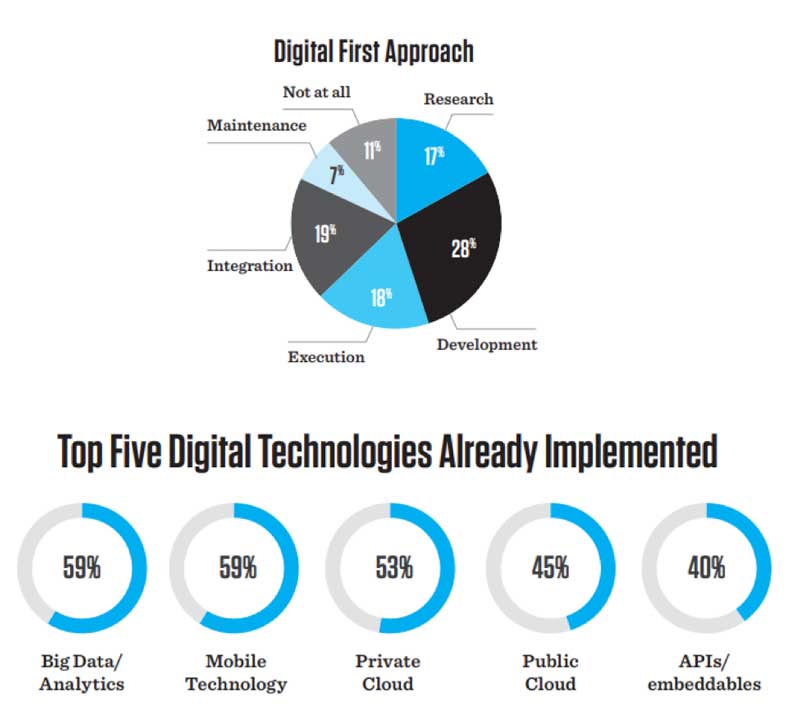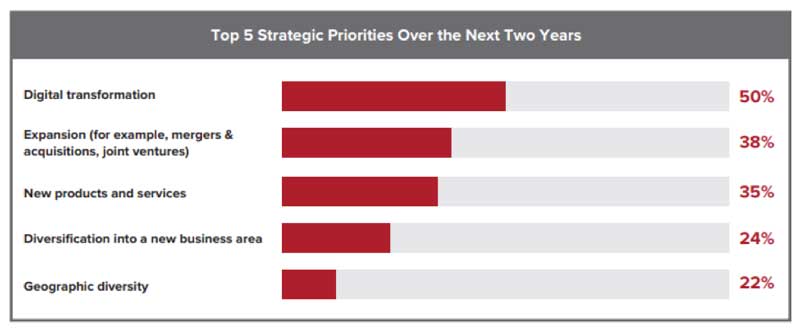For enterprises, processes that bring change or transformation are closely linked to profitability. In contrast, “transformation” for small-to-medium businesses (SMBs), is synonymous with survival or existence. Taken together with the overwhelming reliance of work and life on technology today, digital transformation is becoming inevitable for SMBs too.
The good news is they can now take advantage of the same insights and opportunities once available only to enterprise companies with deep pockets. Technology enables them businesses of any size to deliver cutting-edge customer experiences and maximize value.
The potential to fully leverage information is critical to remaining a viable business. Those that begin now will see that future; those that continue to ignore the signs in favor of “business as usual” may not. The IDG 2018 Digital Business Survey reports that 89% of organizations have plans to adopt a “digital-first” business strategy; yet, only 44% have fully taken this approach so far.

Source: IDG
Before Digital Transformation Comes Digital Adoption
Gartner defines Digital Business Transformation as “the process of exploiting digital technologies and supporting capabilities to create a robust new digital business model.” This is where smart enterprises realize tremendous efficiencies in operational and strategic activities. However, many SMBs will pause when they hear the term “digital business transformation” due to a perception of complexity that is beyond available resources.
That is changing with digital adoption, which is the acceptance and implementation of multiple technologies and tools across the organization and managing them via a single platform, eliminating concerns such as complexity of UI and lack of skills, and improving customer experience in the process.
These tools and technologies include public and private clouds, IoT, hyperconverged infrastructure and data centers, machine learning, big data analytics, and APIs. Companies can determine where the customer is in their journey and tailor products and services at just the time when they need them most.
Cost savings come in the form of moving common practices, which often include manual or paper-based activities, to digital processes. These provide increases in productivity, lessen lead conversion times, and provide relevant, useful and clean data that can be used to make more accurate and timely business decisions. This leads to eventual digital transformation with permanent and wide-ranging implications.
SMBs, however, face unique challenges here. They need the same IT services as larger enterprises in order to compete, but face issues the big businesses don’t have: resources to deal with complexity, lack of in-house skills and expertise, and tight budgets. Add to that the time constraints of both managing the core business and improving it, and pushing transformation out into the future becomes the norm. Let’s see how a rapid and immediate drive towards digital transformation can benefit SMBs that are on their way of growing into full-fledged enterprises.
Simplifying and Shortening Processes
Digital adoption often starts with digitization, which involves turning manual processes into a digital format. This cuts back on paperwork and expedites the process, gaining time and productivity. The use cases and applications for creating digital processes is almost infinite, and often ends up costing much less soon after implementation.
Online and interactive processes are intuitive and faster. They limit errors and increase the accuracy and volume of data that is available to the company. For example, forms such as work orders, shipping data, and sales calls can be linked among applications and processes, with information moving automatically to the next destination point on the customer journey. This significantly shortens time to completion and eliminates rework. Imagine a sales or service request that never has to be sent back for more information or corrections!
A move towards digital processes connects business goals with the technologies being used. This does away with staff’s lack of understanding about how the process matters to the organization. More importantly, it helps align the purpose of the organization by creating and adaptive culture that puts strategy before structure.
Niel Nickolaisen, CTO at O. C. Tanner Co., put it more clearly: “Given the pace of change in IT, it seems logical to me that creating an adaptive culture – one that is willing to constantly reinvent itself – is the only way to keep pace in such a dynamic marketplace.” He developed the decision framework model, using which SMBs can ensure that IT resources are always focused where they will deliver the most business value:

Source: Nutanix Magazine
Doing Without Specialized Skills
In many SMBs, IT staff are generalists, handling applications, user questions, mobile apps, desktops, servers, storage and networking for the entire company. Skills to manage large data pools, configure hybrid, multicloud environments, and fortifying security of disparate systems can be strained.
The availability of cloud-based applications and infrastructures for maximizing efficiencies, predictive forecasting, and process automation comes with the need for expert staff in deploying and managing all these. However, deployment of advanced cloud computing systems is no longer a barrier for SMBs – technologies such as hyperconvergence offer more flexibility, security, resilience, and scalability in the IT infrastructure.
Moreover, all of these can be managed via a ‘single pane of glass’ interface that doesn’t require deep IT expertise on part of IT support staff:
Eliminating the need to maintain servers on premise frees up IT staff for business-related activities and helps them focus on strategic goals. Further, there is less dependence on external vendors and proprietary technologies, resulting in lower total cost of ownership (TCO) of technology and more accuracy in routine as well as mission-critical operations.
Speaking of lower TCO…
Working (Well) with Tighter Budgets
Moving into a digital business model will actually reduce overall expenditure, including budgets for storage space, computing power for applications, and IT training programs. This results in improved operational productivity – time taken to complete an order, process a shipment, close month-end financials reduces notably, rapidly adding up on cost savings. SMBs can always find a way to redirect saved dollars towards growth or profitable activities.
A joint report from Ensono and the Cloud Industry Forum found that cost savings in business were the primary driver for digital transformation, according to 68% of the decision-makers polled. Further, nearly a third of IT decision makers surveyed in the IDC report referred to earlier claimed that digital business has already helped their organization achieve significant revenue growth.
Driving this revenue growth is the collection, mining, and application of data that is a byproduct of newer technology and digital transformation. Sales, Marketing and Customer Service departments are finding tremendous value in this business data. They can create targeted campaigns with higher returns and lower costs, solutions that are more customized and content that is personalized and considerably more relevant to the customer.
Service and support areas can see data on the customer’s journey, having specific items brought to their attention to address first. Deeper and more personal engagement with the contact improves customer satisfaction rates. Happy customers who feel recognized and known by their vendors are more likely to stay and buy again. And guess who brings revenue to the party?
SMBs can benefit in reducing overall operating costs and using all resources and functions of the business to be used in decision making; every department can make accurate forecasts and valuable contributions to the revenue model based on real data instead of guesswork. Malcolm Frank, Chief Strategy Officer at Cognizant, hit the nail on the head when he declared, “Winners and losers in the digital world get separated at the data level.”
The Golden Goose
Digital transformation is a continuous and never-ending process that keeps bringing benefits to the organization and aids growth incessantly. Which is why it is the top priority of top execs, as per a Forbes study. Needless to say, what the enterprises are focusing on today, trickles down to SMBs tomorrow.

Source: Forbes
Organizations can put themselves on the road to digital transformation and foster a digital culture with a few simple steps:
Always keep in mind your primary objective for transformation
Directly addresses employees’ concerns about technology and change
Work with a partner or MSP who has experience in effecting digital transformation, either for themselves or for a client
Always focus on transforming the customer journey first, by making it quicker and simpler
Stay aware of technology enablers in the market. Encourage agility and innovation in the organization
Facilitate and reward inter-departmental collaboration
At the end of the day, business transformation is critical to a company’s ability to remain competitive and viable. There is no visible end to future improvements and new technologies, so charting a transformation roadmap right away will set the tone and pace for the business’ future, especially when growth is central to survival.
Dipti Parmar is a contributing writer. She writes for major tech and business publications such as CIO.com, CMO.com, Entrepreneur and Inc. magazines. Follow her on Twitter @dipTparmar.
© 2020 Nutanix, Inc. All rights reserved. For additional legal information, please go here.


